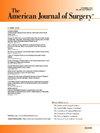Localization procedure for breast lesions at time of biopsy – Which patients would benefit?
IF 2.7
3区 医学
Q1 SURGERY
引用次数: 0
Abstract
Background
The diagnosis and treatment of non-palpable breast lesions is a multistep pathway that can involve imaging, tissue biopsy, clip placement, localization, and surgical resection. To minimize the procedural burden on patients, placement of localization seeds at time of initial biopsy has been considered. However, benefit to this patient population remains unclear. This study, therefore, aimed to determine the number of patients within our own institution that may benefit from upfront localization and characterize an appropriate target population.
Methods
A single institution retrospective cross-sectional study was conducted with assessment of all patients who underwent core needle biopsy (CNB) and/or breast cancer surgery at a regional high-volume breast centre between January 1 and December 31, 2018. Patients who underwent CNB with a subsequent radiological localization procedure and breast cancer surgeries that utilized localization were evaluated in order to model seed use.
Results
In total, 314 CNB and 634 breast cancer surgeries were performed. Within the CNB cohort, 60 (19.1 %) required localization. Of the breast cancer surgeries performed, 420 (66.2 %) were breast-conserving surgery and 303 (47.8 %) required localization.
Conclusion
With some localization technologies, the localization procedure can be coupled with biopsy and eliminate the need for a clip as the length of implantation is unrestricted. That said, our institutional data suggests that only a small portion of patients undergoing breast biopsy would benefit from upfront localization and a minority of breast cancer surgeries require localization. Further characterization of this specific patient population is needed to streamline management pathways.
求助全文
约1分钟内获得全文
求助全文
来源期刊
CiteScore
5.00
自引率
6.70%
发文量
570
审稿时长
56 days
期刊介绍:
The American Journal of Surgery® is a peer-reviewed journal designed for the general surgeon who performs abdominal, cancer, vascular, head and neck, breast, colorectal, and other forms of surgery. AJS is the official journal of 7 major surgical societies* and publishes their official papers as well as independently submitted clinical studies, editorials, reviews, brief reports, correspondence and book reviews.

 求助内容:
求助内容: 应助结果提醒方式:
应助结果提醒方式:


